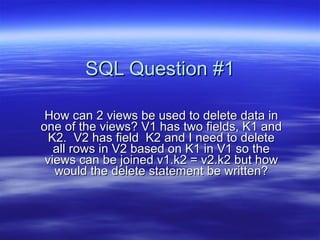SQL Question Tip
•
0 recomendaciones•536 vistas
SQL Question used in Class.
Denunciar
Compartir
Denunciar
Compartir

Recomendados
Más contenido relacionado
Más de Kai Liu
Más de Kai Liu (14)
Último
Último (20)
Six Myths about Ontologies: The Basics of Formal Ontology

Six Myths about Ontologies: The Basics of Formal Ontology
Apidays New York 2024 - The value of a flexible API Management solution for O...

Apidays New York 2024 - The value of a flexible API Management solution for O...
Apidays New York 2024 - The Good, the Bad and the Governed by David O'Neill, ...

Apidays New York 2024 - The Good, the Bad and the Governed by David O'Neill, ...
ProductAnonymous-April2024-WinProductDiscovery-MelissaKlemke

ProductAnonymous-April2024-WinProductDiscovery-MelissaKlemke
Navigating the Deluge_ Dubai Floods and the Resilience of Dubai International...

Navigating the Deluge_ Dubai Floods and the Resilience of Dubai International...
Biography Of Angeliki Cooney | Senior Vice President Life Sciences | Albany, ...

Biography Of Angeliki Cooney | Senior Vice President Life Sciences | Albany, ...
Cloud Frontiers: A Deep Dive into Serverless Spatial Data and FME

Cloud Frontiers: A Deep Dive into Serverless Spatial Data and FME
TrustArc Webinar - Unlock the Power of AI-Driven Data Discovery

TrustArc Webinar - Unlock the Power of AI-Driven Data Discovery
Apidays New York 2024 - APIs in 2030: The Risk of Technological Sleepwalk by ...

Apidays New York 2024 - APIs in 2030: The Risk of Technological Sleepwalk by ...
DEV meet-up UiPath Document Understanding May 7 2024 Amsterdam

DEV meet-up UiPath Document Understanding May 7 2024 Amsterdam
Apidays New York 2024 - Accelerating FinTech Innovation by Vasa Krishnan, Fin...

Apidays New York 2024 - Accelerating FinTech Innovation by Vasa Krishnan, Fin...
CNIC Information System with Pakdata Cf In Pakistan

CNIC Information System with Pakdata Cf In Pakistan
Boost Fertility New Invention Ups Success Rates.pdf

Boost Fertility New Invention Ups Success Rates.pdf
Strategies for Landing an Oracle DBA Job as a Fresher

Strategies for Landing an Oracle DBA Job as a Fresher
Web Form Automation for Bonterra Impact Management (fka Social Solutions Apri...

Web Form Automation for Bonterra Impact Management (fka Social Solutions Apri...
SQL Question Tip
- 1. SQL Question #1 How can 2 views be used to delete data in one of the views? V1 has two fields, K1 and K2. V2 has field K2 and I need to delete all rows in V2 based on K1 in V1 so the views can be joined v1.k2 = v2.k2 but how would the delete statement be written?
- 2. Choices? 1. delete from V2 2. delete from V2 where K1 in (select V2.K1 where rowid in (select V2.rowid from V2, V1 from V2, V1 where V2.K2 = where V2.K2 = V1.K2); V1.K2); 3. delete from V2 4. delete from V2, V1 where K2 in (select V2.K2 where V1.K2 = V2.K2; from V2, V1 where V2.K2 = V1.K2);
- 3. Answers Both 2 and 3. 2 is better because using rowid would make statement faster.
- 4. What is Rowid? A rowid is a pseudo column (like versions_xid), that uniquely identifies a row within a table, but not within a database. Every record has a unique ROWID within a database representing the physical location on disk where the record lives. Every record has a unique ROWID within a database representing the physical location on disk where the record lives. The ROWID gives us the physical address of a row and is the fastest way to access any row.
- 5. Common Case for Rowid Table V2 has a column "K1", which should be unique, but someone made a mistake and did not add a primary key or unique constraint, and there are now duplicate rows. We want to clean it up.
- 6. SQL Statement delete from V2 a where exists ( select 1 from V2 b where a.K1 = b.K1 and b.ROWID < a.ROWID);
- 7. Explained The self-join query means "Delete all rows that have another row with the same K1, but "lesser" ROWID. Our choice of "lesser", while not logically required, so we prefer to preserve the row that is closer to the beginning of the table. The main point is without the ROWID, the only way to correct this table would be to create a new one based on the results of a query with GROUP BY K1, or to use other columns and methods to differentiate. While feasible, it might not be convenient for various reasons, so it is good to know the ROWID is available.
